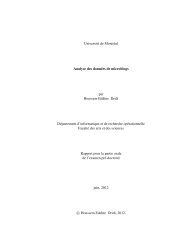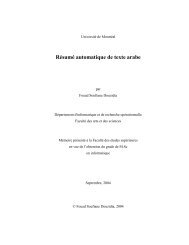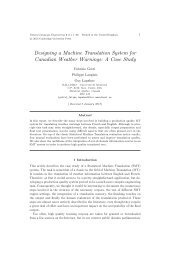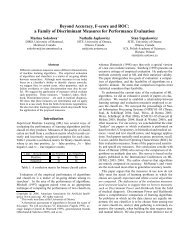A Corpus-based Approach to Weather Report Translation - RALI ...
A Corpus-based Approach to Weather Report Translation - RALI ...
A Corpus-based Approach to Weather Report Translation - RALI ...
- No tags were found...
Create successful ePaper yourself
Turn your PDF publications into a flip-book with our unique Google optimized e-Paper software.
<strong>to</strong> write their reports in natural language rather<br />
than selecting text structure templates.<br />
Given that recent statistical and corpus approaches<br />
for machine translation have proven<br />
their value in some contexts, we decided <strong>to</strong> see<br />
how well these approaches would fit in the context<br />
of the weather report translation. We obtained<br />
from Environment Canada 309 531 forecast<br />
reports in both French and English produced<br />
during 2002 and 2003. The current reports<br />
are available on the web at http://meteo.<br />
ec.gc.ca/forecast/textforecast_f.html. This<br />
site is continually being updated. We used this<br />
corpus as a source for developing a new system<br />
for weather reports and thus gave rebirth <strong>to</strong> one<br />
of the most successful machine translation system<br />
until now.<br />
We describe in section 2 the data we received<br />
and what preprocessing we performed <strong>to</strong> obtain<br />
our Météo bitext. We present in section 3 the<br />
first pro<strong>to</strong>type we devised and report on its evaluation<br />
in section 4. We finally discuss this work<br />
in section 5.<br />
2 The corpus<br />
As our system is <strong>based</strong> on both memory and statistical<br />
<strong>based</strong> approaches, the first thing we need<br />
is a bitext i.e. an aligned corpus of corresponding<br />
sentences in French and English weather reports.<br />
Like all work on real data, this conceptually<br />
simple task proved <strong>to</strong> be more complicated<br />
that we had initially envisioned. This section<br />
describes the major steps of this stage.<br />
2.1 The raw corpus<br />
We received from Environment Canada files<br />
containing both French and English weather<br />
forecasts produced during 2002 and 2003. Both<br />
the source report, usually in English, and its<br />
translation, produced either by a human or by<br />
the current Météo system, appear in the same<br />
file. One file contains all reports issued for a<br />
single day. A report is a fairly short text, on<br />
average 304 words, in a telegraphic style: all<br />
letters are capitalized and non accented and almost<br />
always without any punctuation except<br />
for a terminating period. As can be seen in<br />
the example in Figure 1, there are few determiners<br />
such as articles (a or the in English, le<br />
or un in French). A report usually starts with<br />
a code identifying the source which issued the<br />
report. For example, in FPCN18 CWUL 312130,<br />
312130 indicates that the report was produced<br />
at 21h30 on the 31st day of the month; CWUL is<br />
a code corresponding <strong>to</strong> Montreal and the western<br />
area of Quebec. A report (almost always)<br />
ends with a closing markup: END or FIN according<br />
on the language of the report; if the author<br />
or the transla<strong>to</strong>r is a human, his or her initials<br />
are added after a slash following the markup.<br />
2.2 Matching English and French<br />
reports<br />
We first determine the beginning and end of<br />
each weather forecast using regular expressions<br />
<strong>to</strong> match the first line of a forecast, which identifies<br />
the source which issued it, and the last line<br />
which usually starts with END or FIN.<br />
Then we distinguish the English forecasts<br />
from the French ones according <strong>to</strong> whether they<br />
ended with END or FIN. Given the fact that<br />
we started with a fairly large amount of data,<br />
we decided <strong>to</strong> discard any forecast that we could<br />
not identify with this process. We were left with<br />
270 402 reports.<br />
We also had <strong>to</strong> match English and French<br />
forecasts that are translations of each other. As<br />
we see in fig. 1, the first line of the two reports is<br />
almost the same except for the first part of the<br />
source identifier which is FPCN18 in English and<br />
FPCN78 in French. After studying the data, we<br />
determined that this shift of 60 between English<br />
and French forecasts identifiers seemed valid for<br />
identifiers from FPCN10 through FPCN29. These<br />
identifiers being the most frequent, we decided<br />
<strong>to</strong> keep only these in<strong>to</strong> our final bitext.<br />
This preprocessing stage required about 1 500<br />
lines of Perl code and few weeks of moni<strong>to</strong>ring.<br />
Out of the 561 megabytes of text we received,<br />
we were left with only 410 megabytes of text,<br />
representing 127 950 weather reports pairs.<br />
2.3 Creating a bitext<br />
To get a bitext out of this selected material, we<br />
first segmented au<strong>to</strong>matically the reports in<strong>to</strong><br />
words and sentences using an in house <strong>to</strong>ol that<br />
we did not try <strong>to</strong> adapt <strong>to</strong> the specificity of the<br />
weather forecasts. Actually, this segmenter did<br />
not always managed <strong>to</strong> identify end of sentences<br />
accurately.<br />
We then ran the Japa sentence<br />
aligner (Langlais et al., 1998) that <strong>to</strong>ok<br />
around 2 hours of a desk workstation <strong>to</strong> identify<br />
4,1 million pairs of sentences from which<br />
we removed about 44 000 (roughly 1%) which<br />
were not one <strong>to</strong> one sentence pairs.<br />
We divided this bitext in<strong>to</strong> three non overlapping<br />
sections as reported in Table 1: train<br />
(January 2002 <strong>to</strong> Oc<strong>to</strong>ber 2003) for training











